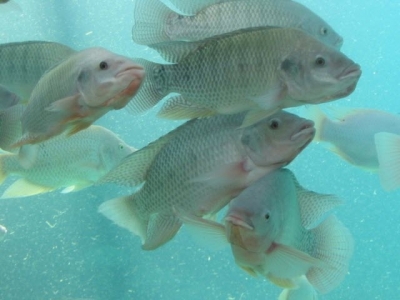Encapsulated yeast strain could boost immune response in fish

Freeze-dried, encapsulated yeast may boost tilapia growth, health and intestinal structure, say researchers from Thailand.
Their study published in Research in Veterinary Science suggests a protected form of Saccharomyces cerevisiae JCM 7255 could be a potential probiotic strain for use in tilapia culture and that the encapsulation technique used improved the viability of yeast during processing and storage.
“Taken together, the data from these experiments show that a combination of alginate encapsulation and 10% skim milk is suitable to improve the viability of S. cerevisiae during storage and during exposure to simulated gastro-intestinal condition,” the scientists said. “Encapsulated S. cerevisiae JCM 7255 can improve intestinal structure and growth performance in tilapia. Induction of gut immune parameters and inhibition against streptococcal bacteria were also noted.”
Tilapia production is rapidly growing as the species is recognized as an important freshwater fish protein source for human consumption, said the authors. “In order to meet consumer demand, intensive tilapia culture is expanding all over the world. At the same time, outbreaks of infectious diseases, including streptococcosis, have been described in tilapia.”
Yeast candidature
The researchers note that, among probiotic candidates, bacteria are recognized as the most common probiotic microorganisms.
“However the transfer of antibiotic resistance genes among probiotic bacteria is widely mentioned by scientific researchers. Other microorganisms such as yeasts are increasingly being considered as alternative promising candidates for probiotics,” they added.
And several S. cerevisiae strains, said the Thai team, contain enzymes, fatty acids, vitamins and amino acids.
“Their immunostimulant components such as beta glucans, nucleic acids and mannan oligosaccharides have been shown to activate the immune response,” said the researchers.
Delivering yeast supplements
One challenge to using live yeast as a probiotic is ensuring that the organism survives until it reaches the intestinal tract, said researchers. The probiotic was tested in encapsulations of an alginate matrix and the matrix with 10% skim milk and tested against simulated gastric liquid and bile.
“The viability of encapsulated S. cerevisiae in skim milk-alginate capsules was significantly higher than in alginate capsules,” the researchers said. But, both types of encapsulation survived longer at room temperature and in gastric and bile simulations than the non-encapsulated or free probiotic.
“The survival rate of free probiotics was significantly reduced after exposure to simulated gastric and bile conditions, which confirms the loss of viability during transit to the action site in the diverse conditions of the tilapia intestine,” they said.
The findings should facilitate future use of the yeast probiotic, added the scientists.
Yeast experiment
In the experiment, 90 fish were split into three groups and fed one of three diets. These included a control, the encapsulated yeast and free capsule yeast. Tests were run three times.
On days 0 and 30, fish from each group were sampled to record the amount of intestinal microorganisms including yeast, total bacteria and the lactic acid bacteria. Fish were weighed on day 0, day 14 and day 30 of the experiment to establish weight gain, growth rate and the feed conversion ratio.
On day 30, segments of intestine were collected from some fish getting each diet to measure intestinal fold length, record acidophilic granulocytes and determine mucous cells.
After the 30 days, fish were challenged with a strain of S. agalactiae and the mortality rate was recorded for 14 days.
Results
Fish fed the encapsulated diet had the largest weight gain and growth rate, said the researchers. That group also had the lowest feed conversion ratio.
Also, fish getting the encapsulated supplement had higher intestinal folds in the proximal and distal parts of the intestines compared to control, though no difference for the three groups was seen in the mid-intestine.
“The acidophilic granulocytes in the capsule group were higher than in the control and encapsulated S. cerevisiae groups in the proximal and middle parts of the intestines,” the team said. “The acidophilic granulocytes in the distal part of the intestine in the encapsulated S. cerevisiae group were higher than in the control and capsule groups. Intraepithelial lymphocytes in the encapsulated S. cerevisiae group were significantly greater than in the control and capsule groups in the proximal part of the intestine.”
In the mucous cells, the encapsulated yeast had the lowest amount of cells in the mid-intestine and all other results were similar for each diet, the scientists said.
After the disease challenge, fish death ended on day three for fish getting the encapsulated yeast, while the control and capsule groups continued to die through days 11 and 14, they said. However, the mortality rates were not considered statistically significant, ranging from 70% mortality in the encapsulated group to 90% mortality in the control.
The yeast strain appears to not be effective against an oral streptococcal challenge, researchers concluded. But, the immune response generated might be important for bacterial pathogens.
“Further studies to examine the effects of encapsulated probiotic organisms on the immune response of fish following long-term storage should be conducted prior to practical application in aquaculture,” they added.
Related news
 Fish farming – coping with heat
Fish farming – coping with heat An increase in water temperature means a depletion in oxygen levels. How do tunnel-based fish farms cope with extreme heat and ensure that fish receive
 A better way to do aquaponics
A better way to do aquaponics The traditional aquaponics single-unit system disadvantages the fish, the plants or both. Now might be the right time to rethink the design.
 Probiotics may offer Atlantic salmon, trout protection against cold-water disease
Probiotics may offer Atlantic salmon, trout protection against cold-water disease A probiotic treatment may help protect salmonid species from cold-water disease. Probiotic protection also may offer a way to reduce the use of antibiotics